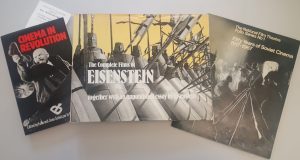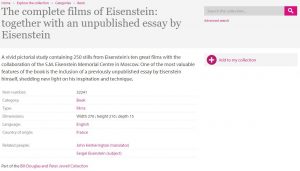Introduction:
This week we looked into the catalogue of Bill Douglas Cinema Museum to find few books, which helped us to understand Soviet Cinema and Eisenstein’s major contribution. To start our project, we searched the keyword Eisenstein in the BDC museum’s website. We were provided with a huge list, in which we picked few books to work with.
About the Book we Chose:
The item we chose was a book called “The complete films of Eisenstein” translated by John Hetherington. This book can show us the film biography of Eisenstein. In the film biography it looks into each film and its criticism, the date they we’re published and his life story. Living all around the world Eisenstein was impacted by different cultures which later impacted his work. It looks into propaganda and how soviet cinema was used for revolutionary ideas. Russia as a country was cut off from the world film market however by 1917 Russian film producers dominated the home market but they run short of equipment. Eisenstein describes “there was a heaviness in those years when the new techniques and montages and revolutionary documentaries and unstudied acting was being discovered and refined”. However the book cant tell us that a pre-revolutionary context, there isn’t much analysis of his films. There isn’t in-depth information on mise en scène, lighting and sound that was used in each of these movies.
Overall, this book helped us gather a further understanding of Eisenstein and his work however only briefly touches on the analysis behind the films. It looks into his inspiration and techniques, which helps us to understand who Eisenstein was in terms of a timeline.
Limitations of BDC Museum’s Catalogue:
The website itself is an awesome way to explore the museum digitally. The user-
friendly interface, it helped us to easily navigate to different pages. Explore the collection page with the search bar was much more helpful to find what we were looking for. However, one of the limitations that the website has is the fact that it doesn’t provide any images of the search result. We wish there were pictures of the catalogue, as it was hard to know what we are looking for when you don’t know what it looks like. Another issues was the search bar, which didn’t work in a mobile device, as it automatically kept disappearing. On the other hand, the search function was working excellent on a PC/Laptop. With the help of the breadcrumb navigation and the advance search option (allowed us to filter our search results), we were able to easily pick the one that we were looking for.
BDC Museum’s Archive:
The archive that we would go for will be the “Bill Douglas Centre Archives”. The reason for this is because, the museum itself is name after him, as he is the one that started collecting these. So, it would be a great experience to know more about him and his work. Mostly we will be interest on “What inspired him to start this?” and “How he managed to be the person, that he is today?”



This is a comprehensive response to this week’s task and you clearly took time to go through the Bill Douglas Museum archive. Your example of “The Complete Films of Eisenstein” is a good one, and while it may not have been particularly inspiring, you clearly and concisely articulate the reasons why this was the case which is impressive.
Good use of pictures, but slightly better care could be taken with grammar and syntax in the post, for while the content is strong, your argument is undermined in places by mistakes. This is not a major issue, but something to be cognisant of as a group in the future.
I think you make some fair points about the search engine: some tweaks here would obviously be welcome, even if unfortunately such changes can often be costly which can be an issue for public museums.
Great point about Bill Douglas! I do hope you find time to go through his archives in the near future.
Like the other group, however, this blog post doesn’t fully engage with the criteria set out in the blog task, namely to engage with David Bordwell’s “Doing Film History” and the 5 basic approaches he outlines therein. Specifically he writes:
“There are distinct types of explanation in film history. A standard list would include:
Biographical history: focusing on an individual’s life history
Industrial or economic history: focusing on business practices
Aesthetic history: focusing on film art (form, style, genre)
Technological history: focusing on the materials and machines of film
Social/cultural/political history: focusing on the role of cinema in the larger society”